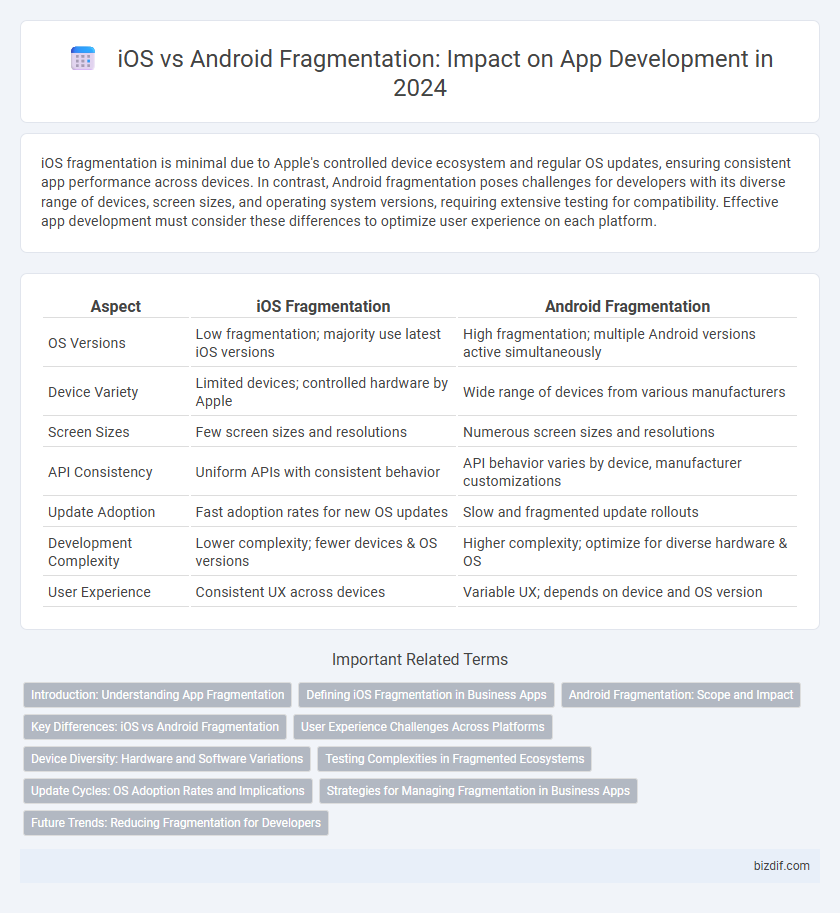iOS fragmentation is minimal due to Apple's controlled device ecosystem and regular OS updates, ensuring consistent app performance across devices. In contrast, Android fragmentation poses challenges for developers with its diverse range of devices, screen sizes, and operating system versions, requiring extensive testing for compatibility. Effective app development must consider these differences to optimize user experience on each platform.
Table of Comparison
| Aspect | iOS Fragmentation | Android Fragmentation |
|---|---|---|
| OS Versions | Low fragmentation; majority use latest iOS versions | High fragmentation; multiple Android versions active simultaneously |
| Device Variety | Limited devices; controlled hardware by Apple | Wide range of devices from various manufacturers |
| Screen Sizes | Few screen sizes and resolutions | Numerous screen sizes and resolutions |
| API Consistency | Uniform APIs with consistent behavior | API behavior varies by device, manufacturer customizations |
| Update Adoption | Fast adoption rates for new OS updates | Slow and fragmented update rollouts |
| Development Complexity | Lower complexity; fewer devices & OS versions | Higher complexity; optimize for diverse hardware & OS |
| User Experience | Consistent UX across devices | Variable UX; depends on device and OS version |
Introduction: Understanding App Fragmentation
iOS fragmentation remains minimal due to Apple's controlled ecosystem and standardized device lineup, resulting in fewer operating system versions and screen sizes to support during app development. Android fragmentation poses significant challenges as the platform spans thousands of device models with diverse hardware specifications, screen resolutions, and OS versions, demanding extensive testing and optimization. Developers prioritize robust compatibility strategies to ensure seamless user experiences across this fragmented Android landscape compared to the more uniform iOS environment.
Defining iOS Fragmentation in Business Apps
iOS fragmentation in business apps refers to the challenges arising from supporting multiple iOS device models and operating system versions, impacting app compatibility and user experience. Unlike Android, where device diversity is vast, iOS fragmentation is relatively limited but still requires careful management of different screen sizes, hardware capabilities, and iOS updates. Effective iOS fragmentation handling ensures seamless app performance, security, and consistent functionality across iPhones, iPads, and iOS versions, crucial for enterprise reliability and user satisfaction.
Android Fragmentation: Scope and Impact
Android fragmentation poses significant challenges in app development due to the vast diversity of devices, operating system versions, and screen sizes, which complicates testing and optimization processes. This fragmentation impacts performance consistency and user experience, requiring developers to implement adaptive designs and extensive compatibility checks. Addressing Android fragmentation effectively demands leveraging flexible development frameworks and regular updates to support the broad device ecosystem.
Key Differences: iOS vs Android Fragmentation
iOS fragmentation is minimal due to Apple's strict control over hardware and operating system updates, resulting in consistent performance across devices. Android fragmentation is significant because of its open-source nature, diverse manufacturers, and varied OS versions, causing challenges in app compatibility and optimization. Developers must account for this disparity by prioritizing uniform OS behavior on iOS and extensive device testing on Android to ensure seamless app functionality.
User Experience Challenges Across Platforms
iOS fragmentation is limited due to Apple's tight control over hardware and software, resulting in a more consistent user experience across devices. In contrast, Android fragmentation spans numerous device types, screen sizes, and OS versions, creating significant challenges for developers in ensuring smooth performance and interface consistency. Managing these disparities requires extensive testing and adaptive design strategies to maintain optimized user experience across diverse Android platforms.
Device Diversity: Hardware and Software Variations
iOS fragmentation remains minimal due to Apple's strict control over hardware and software versions, enabling developers to optimize apps for a limited number of devices with uniform performance. In contrast, Android fragmentation presents significant challenges as thousands of devices feature varying screen sizes, processors, and OS versions, requiring extensive compatibility testing to ensure app functionality across diverse hardware and software environments. This disparity in device diversity impacts development complexity, user experience consistency, and update deployment speed.
Testing Complexities in Fragmented Ecosystems
Testing complexities in iOS fragmentation remain relatively low due to Apple's controlled hardware and software environment, minimizing device variability. In contrast, Android fragmentation presents significant testing challenges, with thousands of device models, diverse OS versions, and custom manufacturer modifications requiring extensive compatibility and performance testing. Automated testing frameworks and cloud-based device farms are essential to efficiently manage these complexities in Android's fragmented ecosystem.
Update Cycles: OS Adoption Rates and Implications
iOS fragmentation is minimal due to Apple's controlled hardware ecosystem and rapid OS adoption, with over 90% of devices running the latest iOS within months of release. In contrast, Android experiences significant fragmentation because of diverse manufacturers and slower update rollouts, resulting in less than 40% of devices running the newest Android version months after launch. This disparity impacts app development strategies, necessitating extensive backward compatibility testing on Android and enabling faster deployment of features optimized for the latest iOS versions.
Strategies for Managing Fragmentation in Business Apps
iOS fragmentation remains limited due to Apple's controlled hardware ecosystem, enabling businesses to optimize apps primarily for the latest iOS versions. Android fragmentation requires comprehensive testing across diverse devices, screen sizes, and OS versions, making tools like Firebase Test Lab and modular app architectures essential for maintaining performance. Employing adaptive UI designs, feature flags, and continuous integration pipelines helps streamline updates and ensure consistent user experiences across both platforms.
Future Trends: Reducing Fragmentation for Developers
Future trends in app development aim to reduce iOS and Android fragmentation through unified development frameworks like Flutter and SwiftUI, which streamline cross-platform compatibility. Both Apple and Google are investing in modular OS updates and standardized APIs to minimize device and OS version discrepancies. Enhanced emulation tools and AI-driven testing also play a significant role in helping developers optimize apps across diverse hardware and software ecosystems.
iOS Fragmentation vs Android Fragmentation Infographic

 bizdif.com
bizdif.com